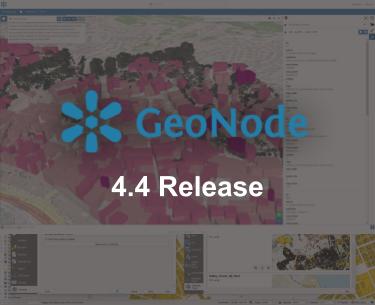GeoNode 4.4 release

Dear Reader,
We are pleased to announce the new stable release of GeoNode, which adds the capability to store local and remote 3D tiles to the catalog of resources, along with several improvements and bug fixes and a new Assets concept.
3D Tiles Resources
3D Tiles visualization was introduced with the previous version of GeoNode, thanks to the updated MapStore framework which powers its client application. However, this capability was limited to single maps, where remote 3D tile assets could be added through the client catalog plugin. With this new version 3D Tiles become first-citizen resources in GeoNode, along with 2D vector datasets, raster files, and documents. 3D Tiles can be published as catalog resources, both from local and remotely served assets, receiving support for all the standard GeoNode functionality such as searching, filtering, sharing, permissions and access management, metadata, linking, etc.
The following video shows both options. In the first part a 3D Tile is created from a remote URL, then an example from a local zip file containing a valid tileset is presented. For both cases, GeoNode expects to obtain a tileset.json file at the root of the URL or find it inside the root folder of the zip file, from where all the needed information to process the tileset (spatial extent, tiles structure, etc.) are retrieved.
Assets
With this version, a new concept has landed into GeoNode, Assets. This model has been introduced to extend and improve the relationship between resources and files that exist behind them, and one of the the motiations behind this change was the support for 3D Tiles and resource attachments.
Files, resulting from the upload of documents and datasets, were kind of hidden behind the scenes and weren’t exposed to the internal GeoNode APIs. Assets introduce a model that makes the management of files explicit and decoupled from resources. For the moment this isn’t visible to end users, but in the future, there might be an asset management area, where files can be uploaded and managed independently from catalog resources. Eventually, a resource can be created from an existing asset at a later stage. This is what GeoNode does now: when a new resource is uploaded, GeoNode creates an asset for the file(s) and then creates a resource connected to these asset(s) through the Link model.
As mentioned before, Assets were also implemented to introduce the option to attach multiple files to a single resource. This is already doable by manually creating an asset and then connecting it to a resource through a link, but this is only doable from the Django admin interface, which is restricted to GeoNode administrators.
Notice that the uploaded files now are stored at the path configured by the new ASSETS_FOLDER settings. When upgrading from a previous version of GeoNode a dedicated command must be executed to migrate files to this new structure.

GeoNode Assets
QGIS GeoNode Plugin v2.0
We are also happy to announce that a new version of the GeoNode plugin for QGIS has been released! The plugin allows users to search, filter, and load resources from a GeoNode catalog from QGIS. It supports authenticated access to the resources through WMS, WFS and WCS, leveraging the GeoNode REST API. Authenticated users can edit the style and data (for vector datasets only) of resources and upload new datasets to GeoNode. Basic metadata information can also be edited directly from QGIS.

QGIS GeoNode Plugin
Version 2.0 fixes a list of long-standing issues and blockers, it introduces several enhancements to the UX and a much more robust handling of errors. Support for legacy GeoNode APIs (GeoNode versions before 4) has been dropped.
The full list of changes and bug fixes for GeoNode can be found in the changelog.
If you are interested in learning about how we can help you achieve your goals with open source products like GeoServer, Mapstore and, GeoNode make sure to talk to us!
The GeoSolutions team


